Here’s a better shot of Little Harbor thanks to my son Dale Robbins on a visit with us to Marblehead on May 30, 2022
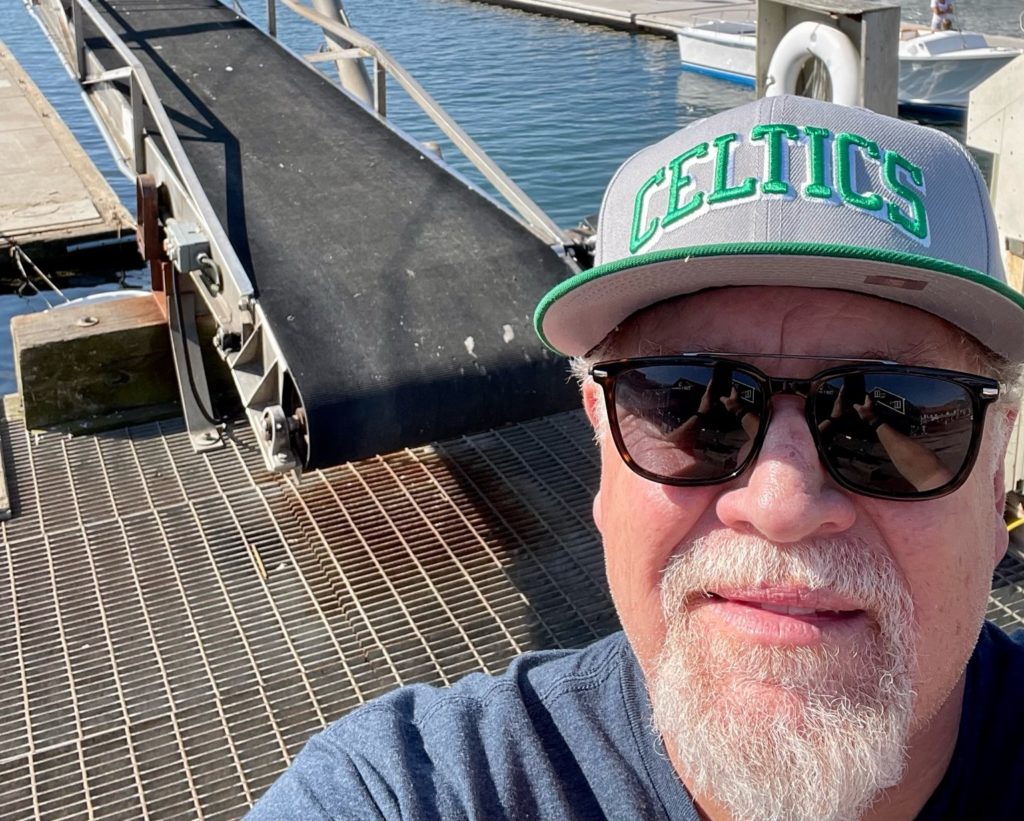

Here’s a better shot of Little Harbor thanks to my son Dale Robbins on a visit with us to Marblehead on May 30, 2022

There was a deserted concrete pier behind the chain link fence where we had expected to find our Soviet ship, the Litva. It was supposed to take us from Piraeus in Greece, via the Bosporus, to Yalta, on the Black Sea where we would fly to Moscow for an international psychology conference. It was 1966 and Helene, my first wife, and I had been married for a year. I was 27 and she was 22.
On Board
An official examined our papers and let us through the fence. We dragged our luggage past six or seven small ships until we came to the vessel with “Litva” in both Roman and Cyrillic characters painted on the stern. We climbed the gangplank and handed our travel documents to the purser, a man in a white uniform. He had a shaved head and bull neck, like the Nazi deputies I had seen in old films of the Reichstag after Hitler took power.
He scanned our papers and dropped our passports and visas into a hole in the railing of the ship. I panicked.
“What about our passports? You can’t take them away from us! We’ll need them for the rest of our trip!” I demanded. He replied slowly in accented English. “Maybe we will send them to you after you reach Yalta.” I was relieved to see other passengers’ passports follow ours into the hole. Maybe keeping our documents was standard procedure.
The purser and everyone who dealt with passengers on the ship belonged to Intourist, the Soviet organization that supervised every aspect of travel for foreigners in the huge communist realm. All tickets, hotel reservations, and meals were detailed on vouchers given to us in New York by the one travel agency permitted to arrange visits by Americans to the Soviet Union.
Below Deck
To save money, Helene and I had separate cabins on the lowest passenger deck. I shared mine with three men, while she bunked with three women. We stowed our luggage and began to explore the ship. We saw two familiar faces; one belonged to a favorite graduate school professor and the other to his colleague who had arrived at the university after I received my degree.
They too were going to the conference in Moscow, and introduced us to two young women, who they said that they were their traveling companions from Turkey. I knew that my professor had recently divorced, but I knew nothing of the colleague’s marital status. I knew that my good friend David, still a graduate student, would have a good laugh when he heard about the Turkish girls. It didn’t surprise me that we saw no sign of the two professors again during our voyage.
Later, on the first day at sea, we dined with Irene and Bob, a couple in their forties, from Florida. Bob was a clinical psychologist also heading for the conference. We ate and lounged around with them for the rest of the cruise. They had been on real cruises and enjoyed joking with us about amenities missing on the Litva.
Instanbul
In the early afternoon of the second day, we docked in Istanbul. We followed other passengers to the lounge where the ship’s staff was to return our passports so we could tour the city. The bald purser in the white uniform was there along with a blond woman in a white uniform blouse. When we reached the head of the queue she said,
“You are not on the list to go ashore.”
“Wait a minute,” I said, “We got on in Piraeus; you must have our passports. I saw the purser drop them into that hole in the rail.”
She searched through papers and I assisted by circling the desk to make sure that she didn’t overlook any lists. Then I spotted a supplementary list of passengers and there we were: Crowley spelled with a K.
When we left the ship for our walk around Istanbul, I felt relieved—the Litva was a Soviet ship, and its officers could hold us on board for as long as they pleased. It happened occasionally in these Cold War days that the Russians detained a randomly selected Western journalist or tourist on charges of espionage, simply to hold for possible exchange for a Soviet spy. After all, they could send us to a Siberian prison camp when we reached a Soviet port.
In Istanbul, I noticed that traffic policemen carried machine guns, which made me relieved that we weren’t driving. We toured the Blue Mosque but arrived at the Topkapi Museum just as it closed. Helene and I had enjoyed the wonderful 1964 movie about a theft from this museum and she longed to see it. She urged me somehow to force the guard to let us in. I’m a shy person and will do almost anything to avoid confrontations with officials, especially when I have fresh images of police with machines guns. “You should have insisted,” she complained.
That evening, Irene, Bob, Helene, and I ate at a well-recommended Istanbul restaurant. Frommer’s book, Europe on Five Dollars a Day, had cautioned us about Turkish bathrooms: Both men and women can expect nothing but a hole in a concrete floor. Bob and I adapted to the holes with no trouble, but we enjoyed teasing Irene and Helene about their visits to the women’s room. We wondered how Turkish women in pantaloons fared.
Frommer had also warned of men who pinched women’s bottoms in the street. Helene had escaped this indignity in Italy, where the practice was supposed to be rampant, but someone got her as the four of us walked back from the Istanbul restaurant.
“It’s because you’re the younger one,” Irene said.
In the afternoons aboard the Litva, we relaxed in the minuscule swimming pool near the stern just forward of the bracket where the Soviet ensign flew. We could hear the thrum of the diesel engines that propelled the ship, especially when I ducked my head underwater. We had the run of the ship, but we were second-class passengers: we bunked near the keel and ate in the second-class dining facility immediately below the promenade deck where first-class passengers dined. Lower even, than our class, were deck passengers who slept in the open, and typically took short hops from one port to the next.
Hapless
Also aboard were Europeans of various nationalities who could not get visas to visit relatives in the Soviet Union but were hoping to contact them somehow while visiting as tourists. One of these people, an elderly Greek woman dressed all in back, shared accommodations with Helene.
Our second port was Varna, Bulgaria, about which I recall little except that its streets were unpaved and its ice cream, sold by the gram by street vendors, was reputed to be the best in the Soviet realm. After we returned to the ship, the crew directed all Western passengers, regardless of class, to use the first-class dining room; there were now Soviet and Soviet-bloc passengers on board and they, regardless of their class of travel, were to dine in the second-class facility. Perhaps the ship’s officers were under orders to limit contact between Soviet citizens and Western tourists.
In Odessa, we were treated to a bus tour of the city. Our Intourist guide emphasized how its heroic citizens used natural caverns beneath the streets to organize their resistance to the Fascist occupiers in the Great Patriotic War.
When we returned to the ship, the elderly Greek woman was weeping on the dock. Apparently, the authorities had prevented her relatives from meeting her.
The ship had a small library, where Helene and I spent some time browsing the collection. As we approached Yalta, where many passengers were to debark, officials collected their travel documents in this library and put blankets over the window to prevent us from seeing in.
Yalta
At length, they cleared us to leave the ship and we were taken to a white hotel with a broad wooden porch near the boardwalk.
We‘d read reports of Soviet bathers who, regardless of girth, wore bikinis and how they changed from street clothes, in full view, without revealing anything that they didn’t want to show. On our first full day in Yalta, we took to the beach to swim in the Black Sea and to witness the bathers.
The changing performances of the Soviet women took place under the boardwalk and were exactly as forecast. No one compromised her modesty. The beach itself was rocky and the Black Sea was warmer than the New England waters in which I swam as a child. Loudspeakers near the beach played martial music and trumpeted numerous announcements in Russian, which I could hear, muffled, from under the water.
That evening, after dinner, we strolled on the boardwalk. A young man in a suit approached and asked in unaccented English,
“Pardon me do you have any cigarettes?” We didn’t, having both quit smoking three years earlier.
“Are you American, we asked?” “No, I’m Russian, but I’ve just graduated from a language institute, and I need to practice my English.”
I was wary. We had been warned about Russians who approached foreign tourists to make illegal currency transactions, and even to buy their clothing. He’s probably KGB, I thought, assigned to monitor tourists. We exchanged a few other pleasantries with him and continued our walk.
A Scary Drive
The next day, Intourist had scheduled a car to take us to the airport in Simferopol, about an hour’s drive to the north. The car was late, and I worried about making our flight. When the car appeared, there was an Intourist official in the front seat.
“I’m sorry for the delay,” he said, “but a Dutch tourist died at another hotel last night and we had to deal with arrangements. I’ll ride with you to the next hotel here in Yalta and then your driver will take you to Simferopol.”
After he left the car, Helene and I realized that the Russian driver spoke no English. We proceeded north through low mountains on a two-lane paved road. Suddenly, he turned off on a dirt road and approached a chain link fence. Again, visions of Siberia multiplied in our minds. He spotted our horrified faces in his rearview mirror, and smiled, saying, “Benzin, Benzin!” as he pointed to the gas gauge that registered near empty. He had two stainless steel teeth in front.
There was a long queue at the pumps, and our driver negotiated forcefully to get us to the head of the line to make our flight. We arrived at the airport with a half-hour to spare.
On to Moscow
The Tupolev Tri-Jet gave us a bumpy ride, flying around 10,000 feet, a feature of Soviet air traffic control perhaps intended to save fuel. Even scarier was the tractor that owed the plane to the end of the runway in Simferopol, before the engines started. A U.S. airline captain to whom I described this practice later was horrified. “What about warming up the engines?” he asked. In Moscow, busses took us to a large Tsarist-era hotel, a few blocks from Red Square.
After I wrote this recollection of the Black Sea cruise, I had to satisfy my curiosity about the white summer hotel in Yalta and about the Litva. In Yalta, now part of Ukraine, modern high rises have replaced the wooden Tsarist-era beach hotels. As for the Litva, here is a May 2006 report from a South African shipping website.
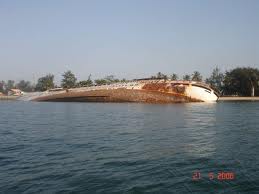
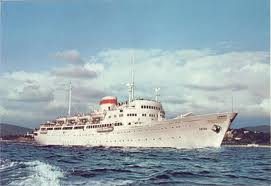
GreenCoast (4,992-gt, ex Litva) which lies in Luanda Harbor, Angola. The passenger ship capsized in Luanda’s Harbour, has been an unwanted resident since 2001 when a Hong Kong-based company attempted to convert her into a floating hotel. The ship was later the subject of an inquiry by the International Transport Federation (ITF) which accused the owners of holding Chinese workers on board in conditions little different from slavery. The project was later abandoned.
Earlier this year the ship capsized after firefighters pumped too much water on board while trying to extinguish a fire. Luanda authorities have since issued a tender for the righting and removal of the wreck. The wreck of Green Coast (Litva) would have little more than passing interest were it not that she is one of the last of the once numerous Soviet Mikhail Kalinin class of passenger ships, having been built in 1960 for Black Sea Shipping.
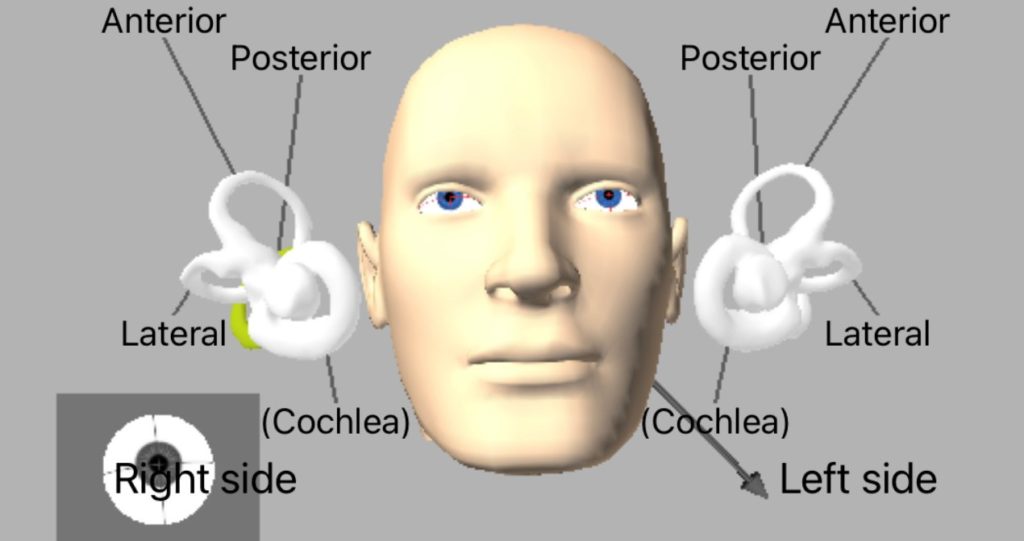
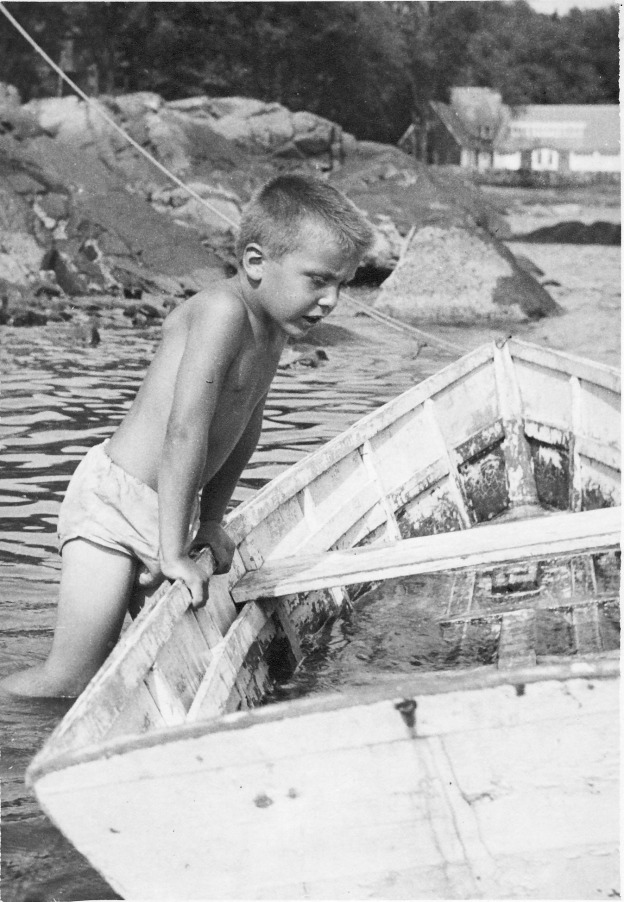

Contact dave@davidecrowley.com to order at a hefty discount from the original price of $21.95! Now $14.95 including priority shipping
Check out the synopsis to learn more: